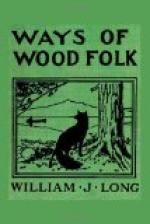So many conditions must be met at once for successful calling, and so warily does a bull approach, that the chances are always strongly against the hunter’s seeing his game. The old bulls are shy from much hunting; the younger ones fear the wrath of an older rival. It is only once in a lifetime, and far back from civilization, where the moose have not been hunted, that one’s call is swiftly answered by a savage old bull that knows no fear. Here one is never sure what response his call will bring; and the spice of excitement, and perhaps danger, is added to the sport.
In illustration of the uncertainty of calling, the writer recalls with considerable pride his first attempt, which was somewhat startling in its success. It was on a lake, far back from the settlements, in northern New Brunswick. One evening, late in August, while returning from fishing, I heard the bellow of a cow moose on a hardwood ridge above me. Along the base of the ridge stretched a bay with grassy shores, very narrow where it entered the lake, but broadening out to fifty yards across, and reaching back half a mile to meet a stream that came down from a smaller lake among the hills. All this I noted carefully while gliding past; for it struck me as an ideal place for moose calling, if one were hunting.
The next evening, while fishing alone in the cold stream referred to, I heard the moose again on the same ridge; and in a sudden spirit of curiosity determined to try the effect of a roar or two on her, in imitation of an old bull. I had never heard of a cow answering the call; and I had no suspicion then that the bull was anywhere near. I was not an expert caller. Under tuition of my Indian (who was himself a rather poor hand at it) I had practised two or three times till he told me, with charming frankness, that possibly a man might mistake me for a moose, if he hadn’t heard one very often. So here was a chance for more practice and a bit of variety. If it frightened her it would do no harm, as we were not hunting.
[Illustration]
Running the canoe quietly ashore below where the moose had called, I peeled the bark from a young birch, rolled it into a trumpet, and, standing on the grassy bank, uttered the deep grunt of a bull two or three times in quick succession. The effect was tremendous. From the summit of the ridge, not two hundred yards above where I stood, the angry challenge of a bull was hurled down upon me out of the woods. Then it seemed as if a steam engine were crashing full speed through the underbrush. In fewer seconds than it takes to write it the canoe was well out into deep water, lying motionless with the bow inshore. A moment later a huge bull plunged through the fringe of alders onto the open bank, gritting his teeth, grunting, stamping the earth savagely, and thrashing the bushes with his great antlers—as ugly a picture as one would care to meet in the woods.




